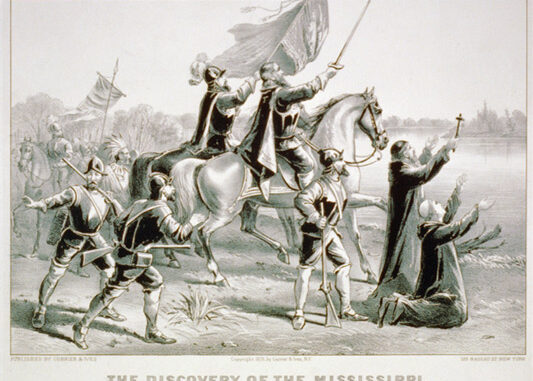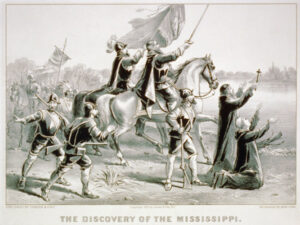

Prints and Photographs Division, Library of Congress,LC-USZC2-2257
Discovery of the Mississippi by de Soto and his followers
Hernando de Soto grew up hearing stories of the famous Spanish explorers and dreamed of being one himself. After an initial stint in the West Indies in 1514 with his patron Pedro Arias Dávila, de Soto joined explorer Francisco Pizarro in 1532 to colonize Peru and greatly debilitate the Incan Empire.
Based on his experiences in South America, de Soto believed that he could explore and colonize Florida and the southeastern part of the modern-day United States. His main goal, like most of the Spanish explorers, was to find gold that could be mined and to establish a small settlement in the area. He traveled to Spain to present his idea to Spain’s King Charles I, and in 1536, the king gave de Soto the provisions he needed for his expedition. However, the king also gave him a timeline of four years to complete the task.
In May of 1539, de Soto landed with ten ships on the west coast of Florida and quickly began his search for gold. Between 620 and 650 people were a part of the entourage, along with horses, pigs, and war dogs. They acquired guides from the Native Americans to help them communicate and navigate the area. They made their way north along the western coast of Florida and set up camp for the winter in the capital of the Apalachee Province near what is known today as Tallahassee. Physical traces of the expedition have been found at this site.
While in Tallahassee, de Soto gathered information about possible gold locations and decided to head northeast into what is now known as Georgia. He and his men continued north into South Carolina, but unfortunately for de Soto, they failed to find any gold. The expedition’s next move was toward the Appalachian Mountains in North Carolina. They continued to follow the Appalachians until they reached the Little Tennessee Valley. They crossed the river, headed south into the area around Lookout Mountain, and then made their way west into Alabama.

JUPITERIMAGES/Thinkstock/Alamy
The Hernando de Soto Bridge over the Mississippi in Memphis, Tennessee
By this time, de Soto’s men were feeling the strain of the journey. Conflicts with the Native Americans were a common occurrence, and many in the expedition had been killed. De Soto’s “conquest of North America” had shown little sign of success. However, in May of 1541, de Soto’s troops arrived at the Mississippi River. His expedition is the first documented European encounter with the river. De Soto’s men took about one month to construct several floats to cross the river, which they finally did near Memphis, Tennessee. They continued to move west into what is now Arkansas, Oklahoma, and Texas. They were the first Europeans to experience the thermal springs in what is known today as Hot Springs, Arkansas. These waters were regarded by the Native Americans as having healing properties, but it’s reported that de Soto only stayed long enough to claim the area for Spain before moving on.
Perhaps de Soto should have stayed a bit longer in the hot springs, because after suffering from a fever, he died on May 21, 1542, on the western banks of the Mississippi River. It’s been said that the others in the expedition had to keep his death a secret because de Soto liked to present himself as an immortal sun god to the Native Americans as a way of making them cooperate without conflict. Though many doubted his claims, de Soto’s men still felt compelled to conceal his death, and so they filled blankets with sand, wrapped up his body, and sank it in the river.
The expedition did go on without de Soto, finally reaching the Spanish frontier town on Pánuco located in the area now known as Mexico. Only about half of the original participants of the de Soto expedition made it to this point. The rest, like de Soto, had been killed by disease or fighting.